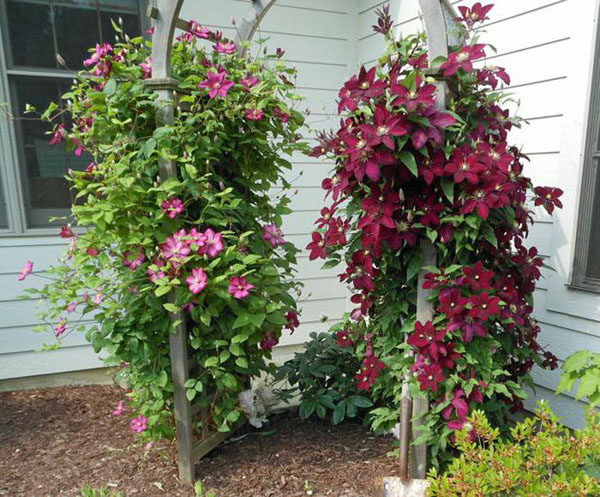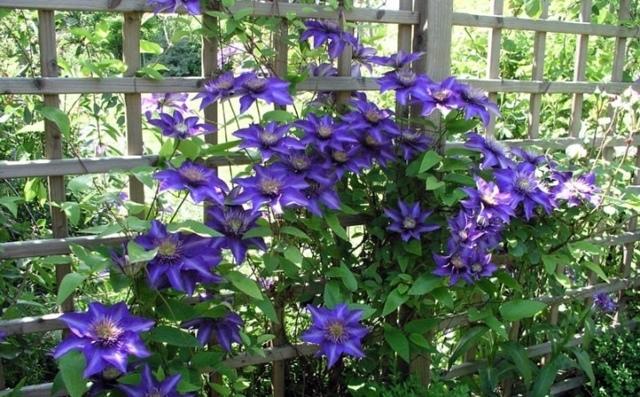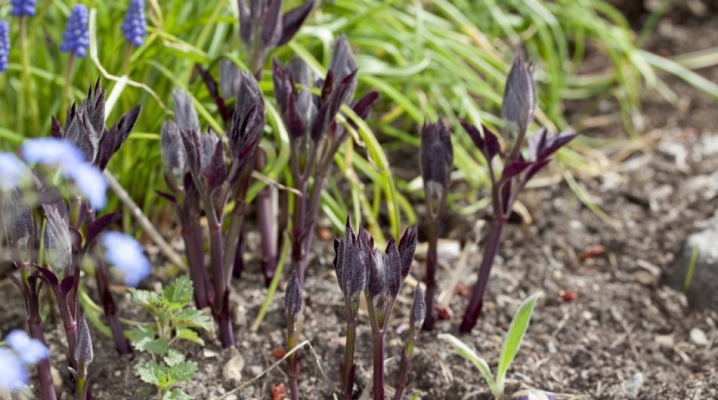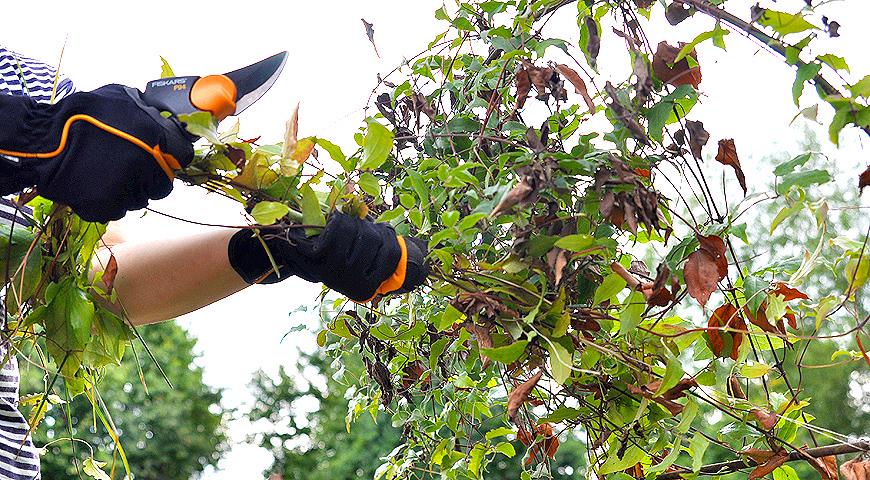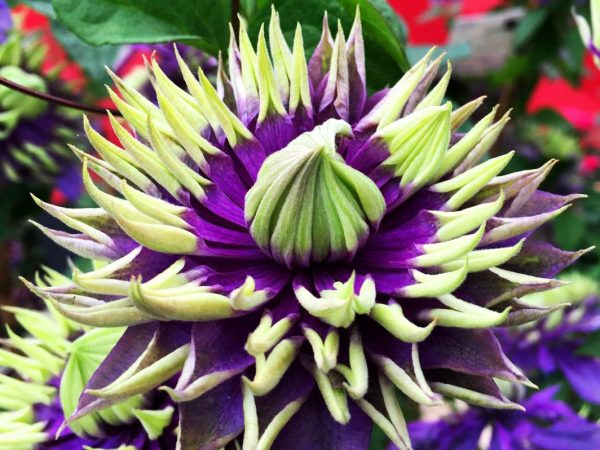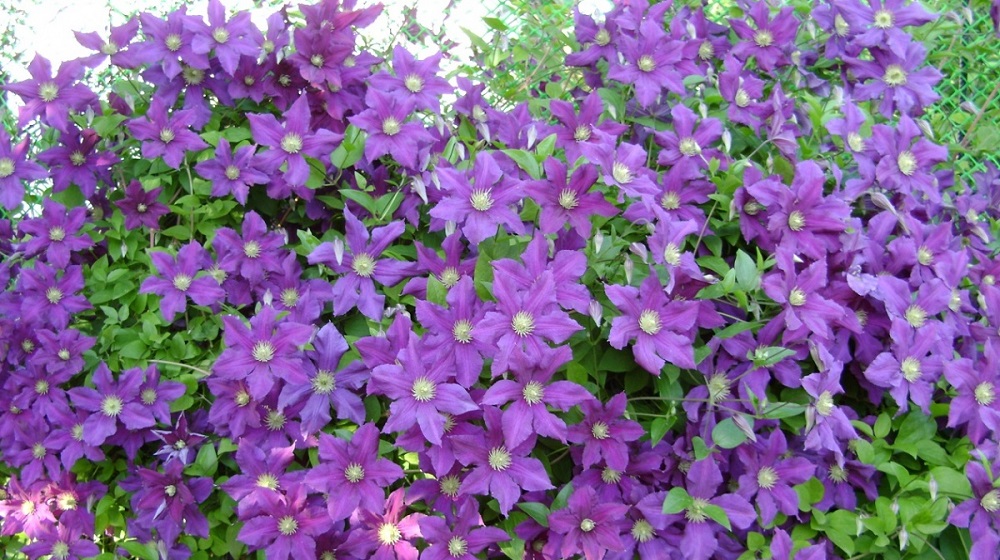Wintering of different varieties
There is a wide variety of clematis varieties, which differ in the height of the bush, the size and shade of the flowers, and the flowering time. Before planting this plant on the site, it is worth choosing the right variety so that it feels comfortable in a certain area
In addition to the main parameters, it is worth paying attention to the plant's resistance to frost. At the moment, the most winter-hardy varieties are distinguished.
- "Abundance" - a variety originally from France, has red or pink flowers. Grows from 2 to 4 meters in height. The winter hardiness of this plant ranges from 28-34 degrees below zero.
- "Avangard" - a variety obtained by chance, but entrenched due to abundant flowering and unusual flowers of red-pink color.
- "Azur Ball" is a new variety with double flowers of a light blue hue. Grows up to 2 meters. The maximum allowable temperature for comfortable wintering should not fall below -30 degrees.
- "Ai-Nor" - a variety bred in the 70s, unpretentious, blooms well, grows up to 2.5 meters in height, the flowers are large, pale pink. A comfortable wintering temperature for him will be from -1 to -20 degrees.
- Alana is a New Zealand variety that has the reddest color currently in existence. It blooms beautifully, but not too profusely.
- Albina Plena is a variety with white flowers with an unusual oblong petal shape. This plant is able to withstand temperatures down to -40 degrees.
- "Alyonushka" is the most popular variety, unpretentious, well-blooming, frost-resistant. For full growth and development, he needs a support to which the bush is tied. The flowers are pink-purple.
If we talk in general about the frost resistance of clematis, then it is imperative to take into account the following nuances
- Plants that bloom on the shoots of this year are most susceptible to the negative effects of frost. If the bush is not cut, then frosty weather will damage a certain part of the shoots, which will be forced to be cut off by gardeners in the spring.
- Clematis blooming on last year's shoots are more frost-hardy. If old shoots freeze, then young vines will bloom in spring, albeit with a slight delay.
- Varieties that winter well, do not need to preserve last year's shoots and simple hilling is enough.
- Adult plants, which are held on supports, may not be removed from them at all, but laid on the ground and covered with a film. The peculiarity of this method is that the leaves are not removed, but remain on the bush. In the absence of diseases, this does not harm, but in the presence of some kind of disease, the bush will die.
The popularity of clematis does not fade, and therefore you can find tall representatives of this plant on arches and partitions, as well as in the company of tall shrubs that bloom in the open field in spring. Low-growing plants are very popular for use in mixborders in company with roses.


See below for preparing clematis for winter.
Preparing for shelter
Clematis, like most other perennials, needs a preparatory autumn stage, which includes a number of activities. Already in August, nitrogen, which stimulates active vegetation, should be excluded from top dressing. The shoots should begin to ripen. In the first half of autumn, they continue to water the vine, if there is no rain. Closer to the shelter, plants need to be pruned, fed and treated against pests - all these actions will help to finally prepare the bush for winter.
Pruning

For its intended purpose, pruning can be sanitary, rejuvenating and formative.In the fall, it is customary for clematis to combine all these types of pruning. The procedure should be carried out 2 weeks before the onset of frost. After this, the plant must recover before the start of covering activities.
For clematis of the first year of life, regardless of the variety, there are general rules for pruning: the shoots are shortened at a height of 20-30 cm, leaving at least 3 buds on each of them. Such pruning will allow the young bush to release many side shoots in the spring and form a lush crown.
Adult clematis are pruned depending on the type to which they belong. In total, 3 groups of lianas can be distinguished, the flowering of which takes place on shoots of different ages:
- In varieties that bloom on last year's increments, only diseased and damaged shoots are completely cut out, and the remaining lashes are shortened to 1.5 meters in length. This group includes such well-known varieties as Cardinal Rouge, Hegley Hybrid, Biryuzinka.
- Some clematis bloom twice in one season. In the first wave, flowers bloom on the shoots of last year, and a little later, flowering begins on fresh young shoots. For them, there is a special pruning technique: the shoots are cut after one, leaving long branches 1.2 m long and short stumps with 2-3 buds. Due to this technique, the flowering bush will look beautiful and neat, forming inflorescences at about the same level. This group includes varieties: Minister, Ball of Flowers, Fair Rosamund, Dawn and others.
- There are also varietal varieties that bloom exclusively on the shoots of the current year. They are cut at a height of 20-30 cm or very close to the ground, leaving only 2 buds. You can not particularly care about the wintering of such clematis, hilling is enough for them. Among the popular plants of this group: Vititsella, Integrifolia, Zhakmana.
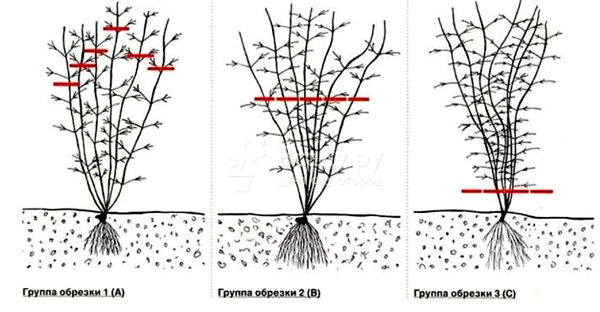 If you do not know which variety your clematis belongs to, leave it to winter with shoots. In the spring, the plant will manifest itself. By the fact that the whips became dry or remained viable, it will be possible to determine the type of vines. Regardless of what type of pruning your clematis needs, you must remove all dry leaves and dried shoots from it. After cleaning the bush, it is better to burn the plant residues.
If you do not know which variety your clematis belongs to, leave it to winter with shoots. In the spring, the plant will manifest itself. By the fact that the whips became dry or remained viable, it will be possible to determine the type of vines. Regardless of what type of pruning your clematis needs, you must remove all dry leaves and dried shoots from it. After cleaning the bush, it is better to burn the plant residues.
Top dressing

If the soil was well fertilized before planting clematis, then the first top dressing is carried out after 3 years. In a meager land, it is necessary to feed the liana in the fall of the year of planting. In early September, compost or humus is applied under the bush, as well as phosphorus-potassium fertilizer. Up to 10 kg of organic matter is consumed per adult plant. Minerals can be given as a solution or in granules. Top dressing should be applied to damp ground so as not to burn the roots.
Fertilizers will help strengthen the roots and improve the immunity of clematis, replenish the supply of nutrients after abundant flowering. Before the very shelter, it will be useful to bring wood ash under the base of the bush and properly tamp it together with the soil. For one instance of clematis, 0.5 kg of ash fertilizer will be required.
Treatment against diseases and pests
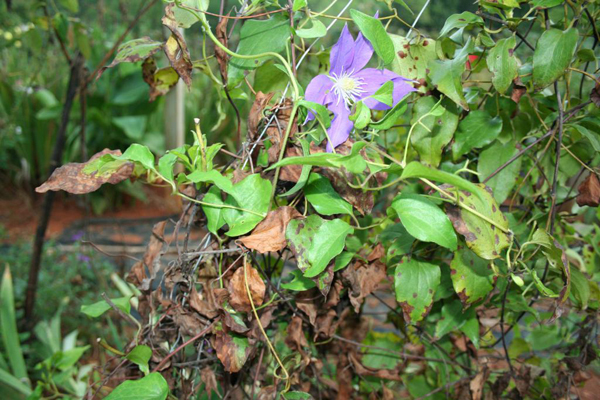
Some summer residents mistakenly believe that one spring preventive treatment for diseases and pests is enough for clematis. In fact, although the shoots are left without leaves under cover, the vine can get sick with fungal disease due to high humidity.
In addition, fungal spores and larvae of harmful insects often hibernate in the upper layers of the soil, and in spring they get out and attack young shoots. Therefore, it is better not to neglect the autumn spraying of the bush and soil treatment. It won't take long, but it will help keep the plant healthy. Proven and effective treatment tools are:
- 1% Bordeaux liquid;
- 3% solution of ferrous sulfate;
- drug Fundazol.
Processing is carried out after the clematis lashes are cut off and plant debris is collected under the bush. The rest of the treatment agent is poured into the trunk circle to disinfect the soil.Spraying should be done in dry weather.
A brief description of the three groups of clematis
The first group of pruning Lianas of the first group form shoots on old (last year's) stems. Therefore, they require minimal pruning, mainly removing only dried and diseased branches. In a more or less warm climate, this type of clematis does not even need to be covered for the winter.
When mild frosts are established (-5), the stems are folded into rings and covered for the winter with a small layer of dry spruce branches or something similar.
The second group of pruning The second group includes large-flowered varieties of clematis flowering twice. The first flowering occurs on old shoots in late spring - early summer, and in late autumn, when new shoots that have grown from old branches have time to fully form, flowers appear on them. Naturally, this process requires suitable climatic conditions, that is, a warm and sunny autumn.
Faded old shoots in the fall must be removed completely, they will no longer give flowers. And young shoots also need to be cut off, but not completely, but only cut their length by a quarter.
When mild frosts are established (-5), the stems are folded into rings and covered for the winter with a small layer of dry spruce branches or something similar.
Third trimming group Third group clematis differs in that flowering occurs only on young shoots almost all summer and early autumn.
All these clematis are cut off completely for the winter, leaving only small stumps from 20 to 50 cm (two to three knots on each shoot). When pruning, you can choose between an abundant number of flowers for the next year, or a large size of flowers. The more buds you leave on each stem, the more flowers there will be, but their size will be smaller. It is not necessary to cover this type of clematis for the winter, it is enough just to spud the bush with compost or peat and cover the hemp with dry branches.
For more information on planting, reproduction and preparation of clematis for the winter, see the article: Clematis - planting and care.
General information about the types and varieties of clematis.
Clematis, climbing roses, wisterias are beautiful climbing plants that can transform your garden. They can decorate an arch, a gazebo, an entrance to a house, or simply disguise an unsightly wall. But clematis has recently had so many new varieties of flowers of different color, size, shape (simple and double, large and small) that you are amazed when you finally try to choose the most beautiful one! And what a variety of colors: white, yellow, pink, crimson, cherry - red, bluish, violet shades, I just want to buy several colors in order to create a composition later.
Some gardeners consider clematis a whimsical plant, since their clematis pruning means cutting off a part and that's it. And they also face a problem - how to cover clematis for the winter. Some of my neighbors completely lost this plant, because the main thing for them was for clematis to bloom actively and beautifully, not at all suspecting that it also needs to be covered! You see! Indeed, the clematis themselves are unpretentious and are perfectly grown in the Middle Lane, and even more so in the southern regions, it is only necessary - what kind of pruning of clematis is needed for a certain species, and and how to cover clematis for the winter correctly.
Do you know that wild clematis (especially its species Clematis cirrhosa var. Balearica and Clematis napaulensis) can generally grow at 12 degrees below zero, and bloom at the same time? But the newly introduced varieties, hybrids, of course, will require more care, they are afraid of frost
Therefore, so that clematis does not freeze out in winter and bloom normally, you need to pay attention to the correct pruning and shelter of clematis for the winter. Clematis photo:

In order for clematis to develop normally in the climate where you live, you need to know the type or variety of clematis, or at least notice - when it blooms and on which shoots. According to the flowering period, clematis are divided into early -, medium -, and late flowering.And by the nature of flowering, clematis are divided into:
1. Blooming on the shoots of the current year;
2. Blooming on last year's shoots;
3. Blooming on last year's shoots and current year's growth.
For the northern regions of the Middle Lane, earlier - and mid-early varieties of clematis with flowering growth of the current year are well suited. Late flowering ones simply do not have time to bloom. For example: André Leroy, Hegley Hybrid, Cardinal Rouge, Biryuzinka and others from the Integrifolia, Jacqueman and Viticella groups. And also, especially, the princes are not afraid of winter - Alpine, Siberian, Okhotsk - these are small-flowered clematis that bloom on last year's shoots.
For a temperate climate, gardeners select clematis, which bloom twice - in the spring on the shoots of last year, and at the end of summer on the shoots of the current year. In temperate climates, clematis have enough light to try to bloom like this. Such clematis are also good in that even if they freeze, they will still bloom on the growth of the current year. For example: varieties Ballerina, Pennell, Fair Rosamund, President, Jeanne d'Arc and others from the groups Patens, Florida, Lanuginoza (partially).
Well, for very mild, southern climates there are such groups of clematis as Jackmani, Vititsella, Lanuginoza, and other varieties of clematis that are afraid of frost. For example, varieties: Madame Baron Willard, Blue Flame, terry varieties Jeanne d'Arc, Daniel Deronda, Lord Neville, etc. These beautiful but demanding varieties of clematis that need careful shelter for the winter (if winter is expected to be cold) and preservation old, last year's shoots for flowering next year. Clematis photo:

It is possible to prevent freezing of clematis in advance, regardless of the variety, if they are planted with a slight deepening, that is, not to deepen the root collar, but to plant the bush so that there are about 10 cm of earth around it.As a result, watering is good, the water does not spread. And also in August it is necessary to reduce the application of nitrogen fertilizers to a minimum, but in September it is necessary to apply potash and phosphorus fertilizers under the bush so that the plant gains strength before wintering (for example, "autumn kemira"). Clematis photo:

How to cover clematis for the winter
Do I need to cover clematis for the winter
It is imperative to cover clematis that grow in the Moscow region, and in central Russia.
These climatic zones do not differ in mild winters, and the plant with a very high degree of probability will simply freeze without proper shelter.
If the stems are left for the winter on the supports to which you tie them up, even if the plant does not die, they will still freeze, and they will come to their senses much more slowly in the spring.
Accordingly, the growth of clematis and its flowering will slow down. The flowers will become small, and the bush will not bloom so abundantly.
If you leave the shoots for the winter on the supports, the stems will freeze and in the spring the plant will gain vegetative mass more slowly, and therefore will bloom weaker.
How to remove clematis from a support
Before covering clematis for the winter, its roots need to be spud about 15 centimeters.
This measure helps well against freezing. prevents excess moisture from accumulating. and allows the roots to breathe.
Then the clematis bush must be removed from the support.
If an adult clematis bush lives in your garden, then this is not so easy to do.
To cope with this task, and not break the bush, in the spring it needs to be tied up only on one side.
Do not try to let the clematis shoots trail along the support - they will braid it in such a way that you simply cannot help but break them when you try to remove clematis from an arch or other structure.

Before removing the clematis, simply cut all the shoots to a height of about 1.5 m
Then you need to cut off the branches and ropes with which the plant holds onto the support.

After that, you can easily lay the easily removable bush on the ground without much difficulty. It will be possible to thin it out (if the bush is not so overgrown that it needs to be divided and cut) it will be possible in the spring.
After that, you can proceed to the most important stage - the correct shelter of clematis for the winter

How to cover clematis for the winter
The most important conditions for clematis to leave for the winter is that the shelter should protect it from both cold and dampness, and at the same time prevent the plant from overheating.
Clematis is still a frost-resistant flower, and its excessive insulation will not do good.
Those varieties of clematis, in which flowers appear on the shoots of the last year, these shoots need to be preserved.
The length of such shoots after pruning should be about 1 m.
They must be very carefully twisted in the form of a ring, and then laid on the ground, pressed from above to the ground with special wire arcs. On top of these rings of branches you need to put spruce branches
Or sprinkle dry leaves
On top of these rings of branches you need to put spruce branches. Or pour dry leaves.
Covering material is placed on top of the leaves (any that does not allow water to pass through), and boards, plywood or pieces of slate are already laid on it.

The fact that the plant can easily endure winter frosts should be done even during planting, and the following conditions must be observed when caring for clematis:
- if you deepen the cutting into the ground so that the place from which the shoots will grow is at least 8 cm in the ground, in the future such a bush will winter well;
- for successful wintering, it is not necessary in the fall, after flowering, to fertilize clematis with nitrogen;
From the addition of nitrogen fertilizer to the kidney, clematis will begin to release shoots that will simply freeze out in winter. And in the spring, when everything starts to melt, such shoots will become a breeding ground for infection;
In the spring, the covering material must be removed from the clematis carefully and gradually in order to protect new buds from spring frosts.
By the way, if in the spring it seemed to you that the bush could not withstand the winter frosts, because it did not have shoots, do not rush to get rid of it.
Perhaps your clematis will sprout new shoots next year. This is quite common.

Rules for removing shelter from clematis
Unraveling clematis should be done as soon as warm weather sets in, even if stable night frosts remain. Clematis are afraid of damping out and thaws much more than frosts, and the bushes should be provided with access to fresh air as soon as possible. Traditionally, the unraveling of clematis begins in April, and ends only in May. Gradual adaptation is also needed to accustom plants to the sun.
 Clematis in the spring. Racquel
Clematis in the spring. Racquel
The shelter is removed in several stages, dividing each one into 2-3 days or a week in time. The first stage should be the opening of ventilation holes on warm days; the removal of the film and the upper layer of the shelter begins only after the threat of severe night frosts and snow melts disappear. Shields are left for a week after removing the film or roofing material.
Do not rush to remove hilling from the bushes: first let the plants adapt to new conditions, and then remove only part of the peat or soil. Leave a light hitch until the night frost completely disappears.
What are Clematis Trim Groups?
If we try to put it briefly, then clematis flowers can grow only on last year's (old) stems. In other types of clematis, flowers can appear simultaneously on both last year's and young branches, that is, they bloom twice, at the beginning of spring on old shoots, and in autumn - on new ones. And finally, the third option: flowers are formed only on young shoots that have grown from buds this year. This is what clematis differ from each other, forming three groups of vines, depending on which the preparation of clematis for the winter will differ, the need for pruning the vines in the fall and its obligatory shelter during the winter.





